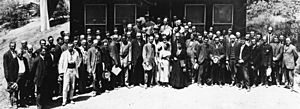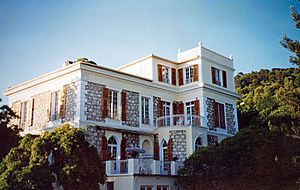Henri Chrétien facts for kids
Quick facts for kids
Henri Jacques Chrétien
|
|
|---|---|

Chrétien at the Fourth Conference International Union for Cooperation in Solar Research at Mount Wilson Observatory, 1910
|
|
| Born | 1 February 1879 |
| Died | 6 February 1956 |
| Nationality | French |
| Scientific career | |
| Fields | Astronomy |
| Institutions | Nice Observatory École supérieure d'optique |
Henri Jacques Chrétien (born February 1, 1879, in Paris, France – died February 6, 1956, in Washington, D.C.) was a brilliant French astronomer and a clever inventor. He created things that changed how we watch movies and how scientists explore space.
Contents
Amazing Inventions
Henri Chrétien is famous for two big inventions. These ideas helped shape both the movie industry and the world of astronomy.
Widescreen Movies
One of his most famous inventions was the anamorphic widescreen process. This special technique used a lens system called Hypergonar. It made movies look much wider, like the CinemaScope films you might see today. This changed how people experienced movies! Before this, movies were usually shown in a narrower format. Chrétien's invention made the picture much bigger and more immersive.
Powerful Telescopes
He also helped invent a special kind of astronomical telescope with George Willis Ritchey. This was called the Ritchey–Chrétien telescope. It was a big improvement over older telescopes. Today, almost all large research telescopes use this design. This means Chrétien's work helps astronomers around the world study distant stars and galaxies.
Early Life and Work
Henri Chrétien was born in Paris, France. He spent part of his early career as an astronomer at the Nice Observatory. This observatory was very close to his home, a beautiful house called Villa Paradou.
The famous French architect Charles Garnier built Villa Paradou. Garnier also designed the famous Opera of Paris. Years later, in 1995, an artist named Rainer Maria Latzke bought and restored the villa. He even added new paintings to the walls.
Chrétien also helped start the Institut d'optique théorique et appliquée (Institute of Theoretical and Applied Optics). He was a professor at a top French engineering school called SupOptique (École supérieure d'optique).
Awards and Honors
Henri Chrétien received many awards for his important work.
- The Chrétien International Research Grants are given to astronomers in his honor.
- In 1901, he won the Prix Jules Janssen. This is the highest award from the French Astronomical Society. He shared it with Joseph Joachim Landerer and Thomas David Anderson.
- He received the Valz Prize from the French Academy of Sciences in 1931.
- A crater on the Moon is named Chrétien in his honor.
- In 1955, he received an Academy Award for his work on the CinemaScope process. This showed how much his invention changed the movie industry.
See also
 In Spanish: Henri Chrétien para niños
In Spanish: Henri Chrétien para niños



